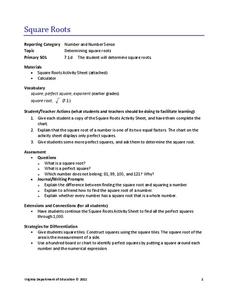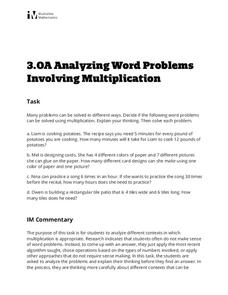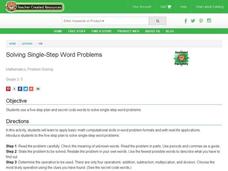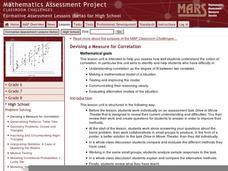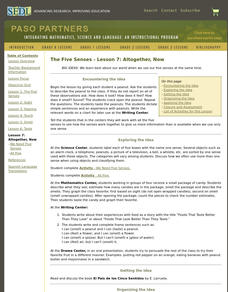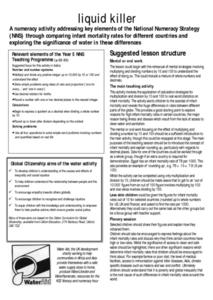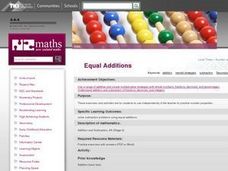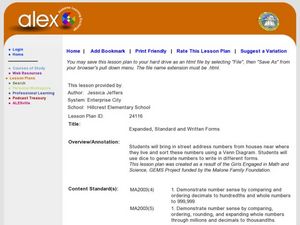Baylor College
Using Food Labels
Help your class make sense of nutrition labels with the ninth lesson plan of this series. After explaining the different information provided on packaged food labels, perform an activity that demonstrates the amount of sugar in a single...
Baylor College
Food for Kids
Immediately capture the attention of your class with the smell of freshly popped popcorn in the sixth lesson of this series on the needs of living things. Young scientists first use their senses to make and record observations of...
American Statistical Association
Colors Challenge!
Does writing the name of a color in a different colored ink affect one's ability to read it? Scholars design an experiment to answer this question. They collect the data, analyze the statistics, and draw a conclusion based on...
Statistics Education Web
How High Can You Jump?
How high can your pupils jump? Learners design an experiment to answer this question. After collecting the data, they create box plots and scatter plots to analyze the data. To finish the lesson, they use the data to draw conclusions.
EngageNY
TASC Transition Curriculum: Workshop 8
Lights, camera, action! Math educators consider how to improve their instruction by examining a model of the five-practice problem-solving model involving a movie theater. Participants examine cognitive demand in relation to problem...
Baylor College
Calculating Exponential Growth
There can be a steep learning curve when teaching about exponential growth, but the lesson helps kids make sense out of the concept. When talking about exponential growth of viruses, learners may not be very interested, but when you are...
PBS
Surface Area and Volume
You and your class will like this lesson on using visual models to relate the volume and surface area of solid shapes. Learners construct three-dimensional forms using nets. They calculate the surface area and volume for each and then...
Virginia Department of Education
Square Roots
Square away any doubts about using a new resource. Pupils learn about squares and square roots in the mini-lesson. They complete a worksheet identifying roots of perfect squares up to 400.
Curated OER
Analyzing Word Problems Involving Multiplication
Learners sometimes have difficulty making sense of a word problem. In a guided learning activity, pupils are asked to think about how to find an answer and explain their thinking, rather than finding the answer. It allows them to...
Curated OER
Shaping Up!
Kindergartners are introduced to basic shapes. Learners spend 45 minutes a day in geometry centers carrying out the activities outlined in this ambitious plan. There are games, hands-on activities, interactive websites, art projects,...
Learn NC
Peanut Butter and Jelly and Order of Operations
Study order of operations using a peanut butter and jelly sandwich activity as your guide. The class watches you make a peanut butter and jelly sandwich based on a volunteer's instructions. They discuss the importance of following...
Curated OER
Solving Single-Step Word Problems
Math wizards learn the five-step plan to solve math word problems. They investigate the five-step process for solving word problems, and examine the use of code words for each of the operations and solve a problem using the strategies.
Curated OER
More or Less Pigs in the Pen
Kindergarteners practice basic addition and subtraction. In this math lesson, students sing a song about pigs on a farm to help them understand the concept of adding and subtracting things together. Some excellent extension activities...
Curated OER
Visiting the Arcade
Second graders take a trip to the arcade in an activity that engages them in problem solving with money. Composed of three word problems, youngsters are instructed to determine various combinations to represent a given value by using...
Curated OER
Devising a Measure for Correlation
How well does your class understand the concept of correlation? Use an activity to explore different methods of calculating correlation. Working alone and then in groups, your class will make decisions on what math to apply to the...
Curated OER
Finding Polygons in Cubist Art
Fourth graders explore geometric properties and relationships in a two-dimensional work of art. They first search for and identify polygons in a Cubist painting and then use polygons to create their own Cubist portrait of a classmate.
Illustrative Mathematics
How is the Weather?
This activity asks learners to interpret data displayed on a graph within the context of the problem. Students are given three graphs that show solar radiation, or intensity of the sun, as a function of time. They are also given three...
Curated OER
Calories in a sports drink
How much can a company round numbers without being misleading? Learners investigate the accuracy of claims made by a sports drink company. Teachers could easily modify the activity by bringing in their own beverage bottles, or by taking...
Curated OER
Altogether, Now
Students apply their five senses to science, math, drama, and writing center activities.
Curated OER
Liquid Killer
Learners explore number sense applications and discuss strategies for multiplication and division using mental math. For cross-curricular purposes, they explore causes and effects of inequality and social injustice. Students explore...
Curated OER
Equal Additions
Students explore the relationships between numbers through the use of "equal addition" and "equal subtraction." Through the use of number sense, they are able to computer addition and subtraction problems mentally. Individually,...
Curated OER
Expanded, Standard and Written Forms
Students explore expanded, standard, and written forms of numbers. In this number sense lesson, students examine the various ways of writing numbers as they complete a Venn diagram activity.
Curated OER
Go Negative
Fourth graders advance to new levels in the lesson we're dealing with here. It is the fourth of a sequence of six dealing with the same theme. These develop from Level 2 to Level 5. In the process they involve number concepts at the...
Curated OER
Applying Estimation in real Life Situations
Fifth graders explore number sense by participating in role-playing activities. In this estimation lesson, 5th graders discuss reasons for estimating amounts in life and read the book Betcha. Students complete a real life estimation...







